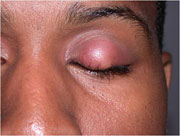Chalazia and Styes

A chalazion and a stye are both lumps in or along the edge of an eyelid. In some situations it may be difficult to distinguish between a chalazion and stye.
A stye is a red, sore lump near the edge of the eyelid. A stye often appears as a red, sore lump near the edge of the eyelid, caused by an infected eyelash follicle. When a stye occurs inside or under the eyelid, it is called an internal hordeolum (pronounced “hor-dee-OH-lum”).

The term chalazion (pronounced kuh-LAY-zee-un) comes from a Greek word meaning “small lump.” A chalazion forms when an oil-producing gland in the eyelid called the meibomian gland becomes enlarged and the gland opening becomes clogged with oil.
Chalazia tend to develop farther from the edge of the eyelid than styes. Often larger than stye, a chalazia usually isn’t painful. It is not caused by an infection from bacteria, and it is not a cancer. Sometimes, when a a stye doesn’t heal, it can turn into a chalazion.
Chalazion and Stye Symptoms
Symptoms of a stye at first generally include eyelid tenderness and redness in the affected area, with irritation and scratchiness in the eye. Further symptoms of a stye include:
- A red bump along the edge of the eyelid at the base of the eyelashes, usually with a small puss spot in the center;
- A feeling as if something is in your eye;
- Sensitivity to light;
- Crusting along the eyelid margin;
- Tearing
What Causes Chalazia and Styes?
A painful, tender stye (also called a hordeolum) is usually caused by a bacterial infection. A stye will develop at the base of an eyelash if the eyelash follicle (root) is infected. This is usually called an external hordeolum. A stye will also develop if there is an infection in one of the tiny lubricating oil glands (called meibomian glands) inside or under the eyelid. When this occurs, it is usually called an internal hordeolum. A stye can also be caused by widespread inflammation of the eyelid from blepharitis, a condition that affects the eyelid margins.
Who Is at Risk for Chalazia or Styes?
Anyone can develop a chalazion or stye, but if you have blepharitis, a condition affecting the eyelid margins, you may be more likely to get either one.
You may also have an increased risk of developing chalazia or styes if you:
- Have had chalazia or styes previously;
- Have skin conditions such as acnea rosacea or seborrheic dermatitis;
- Have other systemic medical conditions, such as diabetes.
- Consistently don’t remove eye makeup completely;
- Use old or contaminated cosmetics.
Chalazion and Stye Treatment
Symptoms of a chalazion or stye are treated with one or more of the following methods:
Warm compresses
Soak a clean washcloth in hot water and apply the cloth to the lid for 10 to 15 minutes, three or five times a day until the chalazion or stye is gone. You should repeatedly soak the cloth in hot water to maintain adequate heat. The warm compress should allow the clogged gland to open and drain white or yellow discharge. If the gland opens, gentle massage around the stye or chalazion may help drainage.
Antibiotic ointments
An antibiotic ointment may be prescribed if bacteria infect a chalazion, or if a stye does not improve after treatment with warm compresses or if it keeps coming back.
Steroid injections
A steroid (cortisone) injection is sometimes used to reduce swelling of a chalazion.
Surgical removal
If a large chalazion or stye does not heal after other treatments or if it affects your vision, your Eye M.D. may need to drain it in surgery. The procedure is usually performed under local anesthesia in your ophthalmologist’s office.
Chalazia and styes usually respond well to treatment, although some people tend to have them recur. If a chalazion comes back in the same place, your ophthalmologist may suggest a biopsy (where a tiny piece of tissue is surgically removed and studied) to rule out more serious problems.
Don’t wear eye makeup or contact lenses until after the stye or chalazion heals.
Chalazion Cysts
Chalazion Cysts form in the wax glands that are in the eyelid. These glands have tiny ducts which open onto the edge of the eyelid, and sometimes, for reasons that we do not understand, one of the ducts may become blocked. When this occurs, the wax that is made by the gland becomes backed up in the duct, and a pea-sized knot, or cyst forms in the eyelid. The cyst may dissolve on its own, or may become spontaneously inflamed and get bigger, and then go down again.
We recommend conservative treatment of Chalazion Cysts. When the children develop significant inflammation, we usually treat the cyst with warmth compresses and antibiotic eye drops. The drops and the warm compresses are used for five days, after which the cysts are usually much smaller and less red, and may dissolve completely. If the cyst persists for several months, or if there are multiple periods of inflammation, then we may consider surgically removing them if it becomes absolutely necessary.
